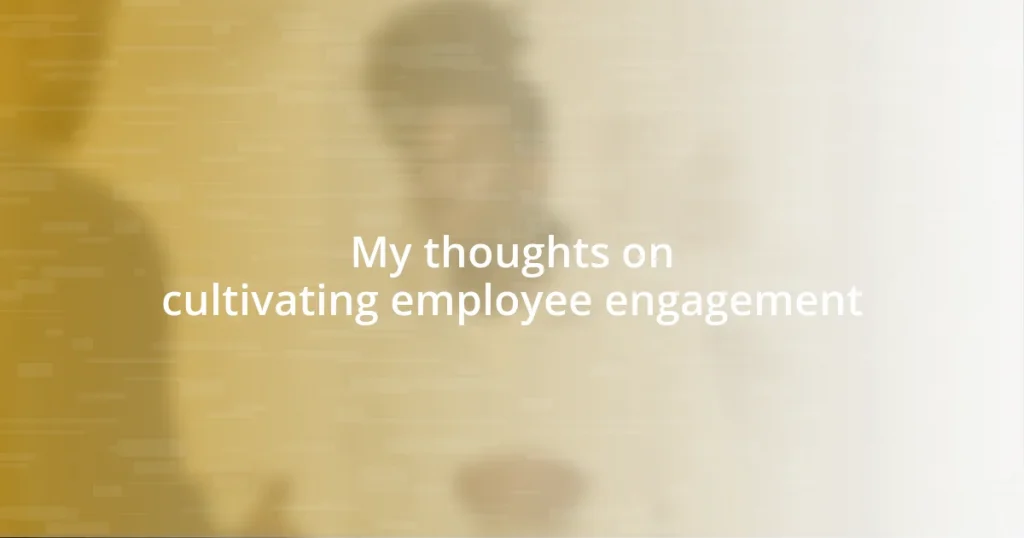Key takeaways:
- Employee engagement boosts productivity, retention, and customer service, as connected team members invest more effort and experience a sense of belonging.
- Effective leadership is crucial for fostering engagement; qualities like active listening, open communication, and enthusiasm inspire trust and collaboration within teams.
- Tailored initiatives, such as mentorship programs and personalized recognition, significantly enhance employee satisfaction and connection, while regular feedback and surveys can drive meaningful workplace improvements.

Understanding employee engagement benefits
One of the key benefits of employee engagement is enhanced productivity. From my experience, when team members feel valued and connected to their work, they naturally invest more effort and creativity into their tasks. Have you ever noticed how a simple “thank you” or recognition can energize a colleague? That boost in morale often translates directly into output.
Another significant advantage lies in employee retention. I’ve often seen how engaged employees are less likely to leave their jobs. When individuals feel proud of their contributions and a sense of community, they’re more inclined to stick around. It’s not just about a paycheck; it’s about belonging. Don’t you think organizations that foster engagement are likely to build stronger teams over time?
Moreover, engaged employees tend to provide better customer service. I remember a time when a team I worked with went above and beyond because they genuinely cared about the clients’ experiences. They weren’t just doing their jobs; they were living the company values, and this passion resonated with customers. Isn’t it fascinating how engagement can ripple outwards, affecting not just the company but also the community it serves?
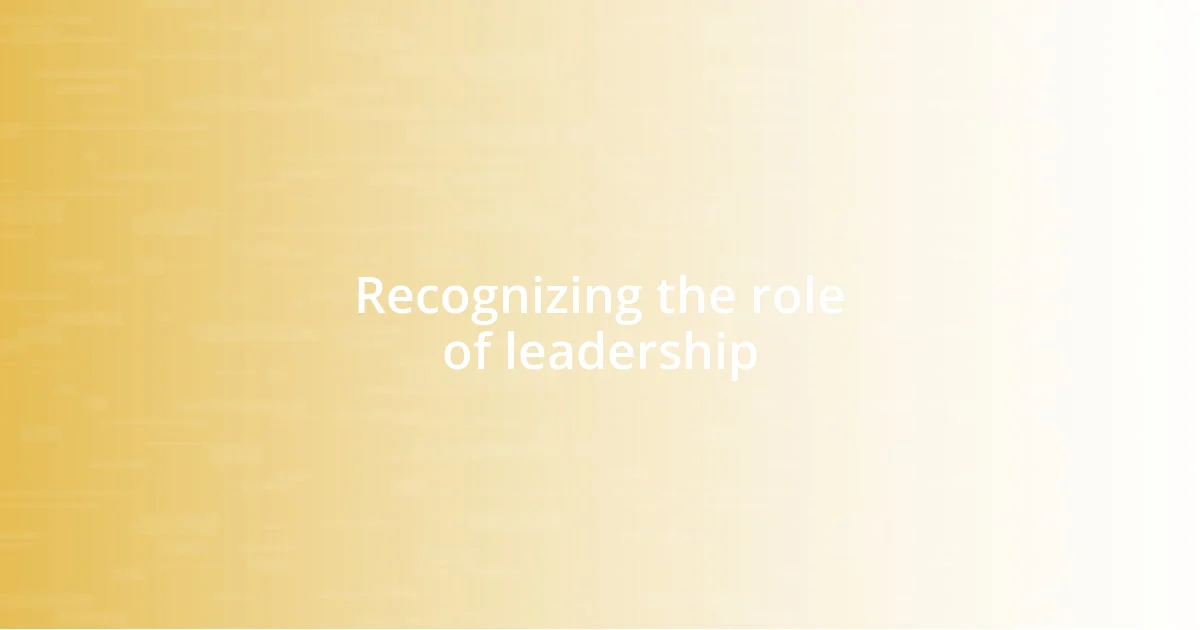
Recognizing the role of leadership
Recognizing the role of leadership in cultivating employee engagement cannot be overstated. I’ve experienced firsthand how effective leaders create a culture where team members feel comfortable sharing their ideas. I recall a project where our team was encouraged to brainstorm openly. The result? Innovative solutions that came directly from our collective input, illustrating just how vital leadership support is in fostering such an environment.
Leadership also plays a pivotal role in setting the tone for communication within a team. In my experience, when leaders actively listen and acknowledge their employees’ concerns, it fosters trust. This trust is crucial because it empowers employees to voice their thoughts without fear of repercussions. I’ve seen this in action during a challenging phase in a previous job. The leader invited feedback through anonymous surveys, and the subsequent changes made all of us feel valued and heard.
Furthermore, leaders who model engagement themselves can have a profound impact on their teams. My former boss was an excellent example of this; she not only shared her vision but also demonstrated enthusiasm every single day. Her positivity was contagious, fostering a spirit of collaboration and shared goals among us. It made me realize that leadership isn’t just about directives; it’s about inspiring others to invest in their own roles.
| Leadership Quality | Impact on Employee Engagement |
|---|---|
| Effective Communication | Encourages open dialogue and trust within the team. |
| Active Listening | Allows employees to share their thoughts and feel valued. |
| Modeling Engagement | Inspires employees through demonstration of energy and enthusiasm. |
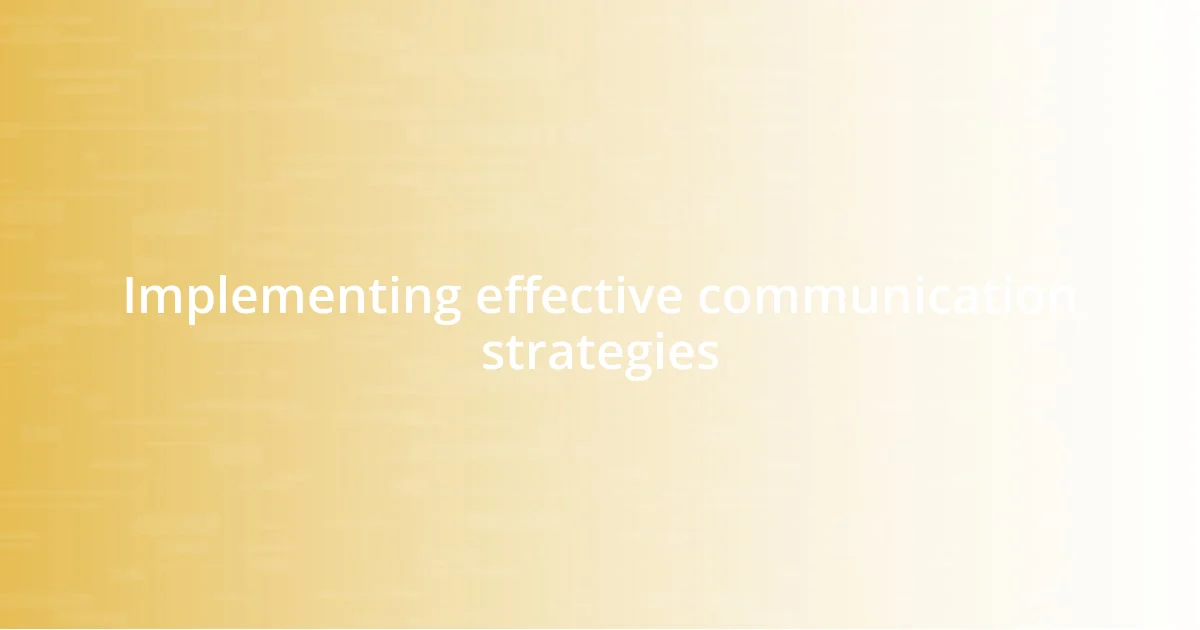
Implementing effective communication strategies
Implementing effective communication strategies is essential for fostering employee engagement. I’ve seen firsthand how regular team meetings can make a world of difference. In one role, we held weekly check-ins that allowed us to share successes and challenges openly. It became a space not just for updates, but for genuine connection, making us feel like a cohesive unit. When employees are encouraged to express their ideas and concerns, it can lead to surprising innovations and strengthened relationships.
To enhance communication strategies, consider these approaches:
- Open-door policies: Encourage employees to share their thoughts freely, knowing their feedback is welcome.
- Regular feedback loops: Initiate brief, consistent updates to discuss progress and solicit input.
- Team-building activities: Organize informal gatherings that foster relaxed interaction, paving the way for more open communication.
- Utilization of communication tools: Platforms like Slack or Microsoft Teams can facilitate quick and effective communication across teams.
- Recognition of contributions: Acknowledge employees’ efforts in group settings; it reinforces their value to the team.
When I worked with a startup, we implemented a monthly ‘appreciation day’ where anyone could spotlight a colleague’s good work. Watching teammates light up when their efforts were recognized was truly inspiring. It brought us closer together and made each of us feel integral to our mission.

Fostering a supportive workplace culture
Creating a supportive workplace culture is something I’m deeply passionate about. One of my favorite memories is from a job where we had a “care corner” — a designated space with resources for mental health and wellness. The atmosphere shifted dramatically when employees began using it openly; it was like a wave of relief washed over us. This simple initiative made it clear that our wellbeing mattered, encouraging everyone to prioritize self-care and fostering a deeper sense of community.
I’ve found that recognition is a cornerstone of support in the workplace. During my time at another company, a colleague started a small tradition of writing handwritten thank-you notes to celebrate individual contributions. It sounds simple, but those notes made us feel truly appreciated and seen. How often do we pause to acknowledge the hard work of those around us? This practice reminded me that fostering support doesn’t always have to be grand gestures; sometimes, it’s the little, thoughtful actions that create lasting bonds among team members.
Moreover, embracing diversity and inclusion is vital for cultivating a supportive culture. Reflecting on a project that involved a diverse team, I noticed how our varied perspectives led to richer discussions and more innovative solutions. It made me think: what if we actively encouraged every voice? When employees feel their unique backgrounds and experiences are valued, it promotes a sense of belonging that enhances engagement. Each person brings something special to the table, and recognizing that elevates the entire workplace.

Encouraging employee feedback and participation
Encouraging employee feedback and participation can transform a workplace. I remember a time when my team initiated an anonymous suggestion box, and the results were eye-opening. Employees felt empowered to share candid opinions about projects and processes without fear of judgment. It unveiled fresh ideas we had never considered and stimulated discussions that improved our workflows. Isn’t it fascinating how giving people a voice can lead to such unexpected innovations?
Another impactful strategy I’ve witnessed is regular brainstorming sessions. One company I worked with held these sessions quarterly, specifically designed for everyone to share their thoughts and pitch solutions to challenges. The atmosphere was electric; everyone contributed, and it felt like we were building something together. It’s incredible how such gatherings can ignite passion among team members and encourage them to take ownership of their ideas. Have you ever experienced that rush of excitement when creativity flows freely in a group setting?
Moreover, integrating formal feedback processes—like quarterly surveys—can also be a game-changer. I participated in an organization that took this very seriously, and we saw how consistently gathering feedback made employees feel valued. Whenever management took action based on our input, it reinforced that our voices truly mattered. It made me wonder: how often do leaders genuinely listen to their teams? The simple act of acknowledging feedback can significantly enhance engagement and foster a culture of collaboration.
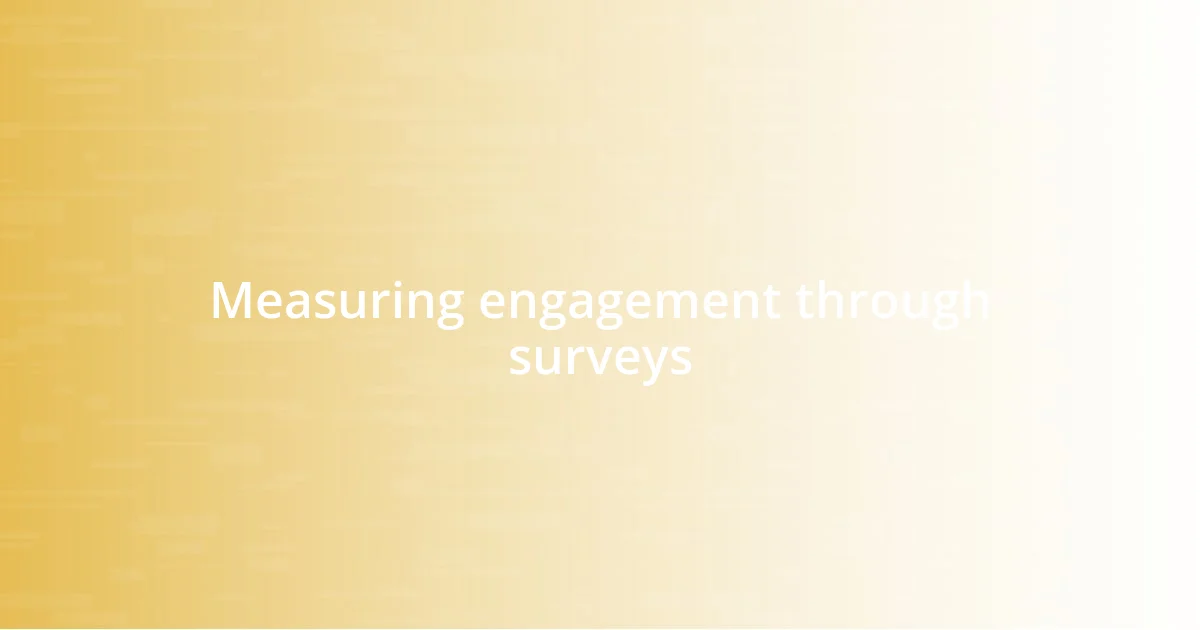
Measuring engagement through surveys
Measuring employee engagement through surveys can be a real eye-opener. I remember my first experience with an engagement survey at a company where I worked. The results were more than just numbers; they revealed genuine feelings and frustrations we didn’t always voice. When management bravely addressed those findings, it fostered a renewed trust among us. Isn’t it powerful to see how data can drive real change?
I’ve also discovered that the way surveys are crafted matters immensely. In one place, we had open-ended questions that encouraged storytelling rather than simple yes-or-no answers. The depth of responses was astonishing—people shared personal experiences that highlighted both triumphs and challenges in the workplace. Those insights sparked conversations that changed how we viewed our roles and connections with one another. Have you ever thought about how a single question can unlock a treasure trove of insights?
Furthermore, timing and frequency play critical roles in making survey results actionable. I’ve experienced the impact of conducting pulse surveys every few months instead of waiting for an annual review. This approach kept engagement levels in continuous focus and allowed us to pivot strategies quickly. When employees see their feedback leading to immediate action, it creates a sense of involvement and shared purpose. Does it make you think about how often you ask for input in your workplace? Regular surveys can be the bridge that transforms employee sentiment into meaningful workplace improvements.
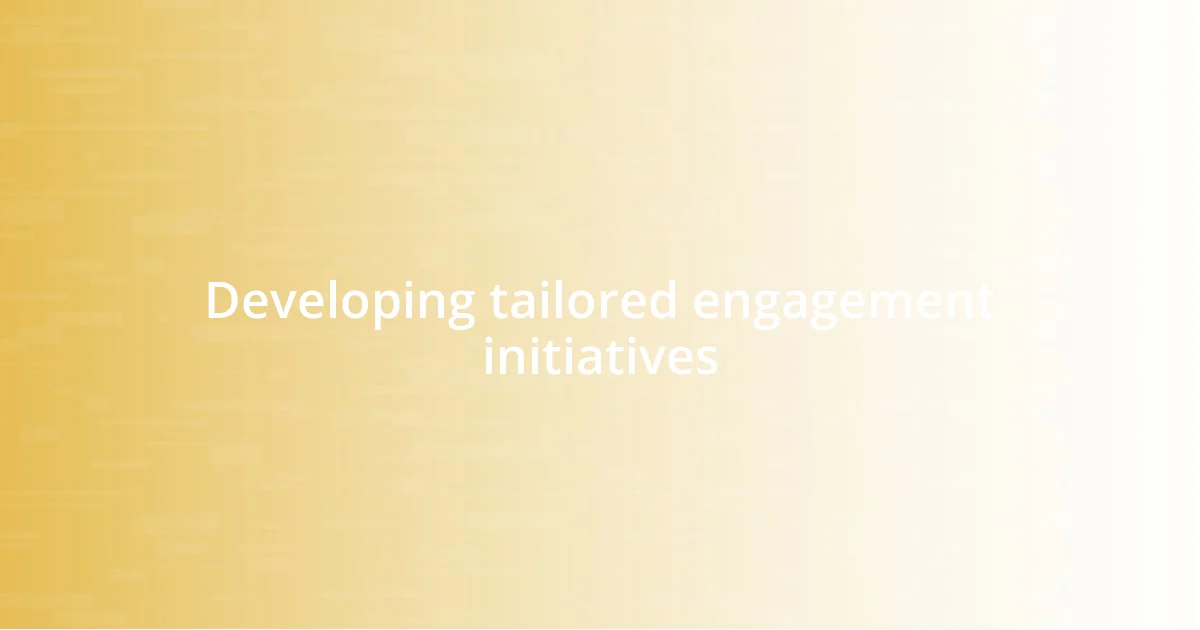
Developing tailored engagement initiatives
Creating tailored engagement initiatives truly makes a difference in how we connect with employees. At one organization where I worked, we launched a mentorship program that paired new hires with experienced team members. It was a simple yet profound step; not only did it enhance skills, but it also fostered a sense of belonging and camaraderie. Can you imagine how impactful it is when someone feels personally guided and supported in their journey?
Another approach I’ve found effective is the personalization of recognition efforts. Rather than generic awards, I helped develop a system where employees could nominate peers for specific attributes that resonated with them. The joy on their faces when receiving recognition that aligned with their contributions was priceless. It made me realize that acknowledgment tailored to the individual can significantly boost morale. How often do we underestimate the power of celebrating unique achievements?
Finally, I’ve seen incredible results from initiatives that focus on work-life balance, such as flexible scheduling or wellness programs. One company I collaborated with offered weekly yoga classes during lunch breaks, and the turnout was beyond what we expected. It was not only about physical health but also about creating an environment where mental well-being was prioritized. It made me reflect: what small changes could have a significant ripple effect on employee satisfaction? Developing initiatives with the individual in mind can transform small gestures into large-scale engagement triumphs.










